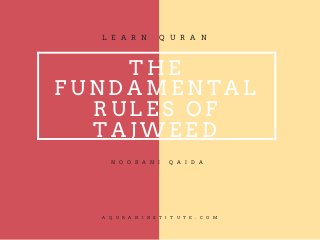
Learn Quran with simple Rules of tajweed
- 1. L E A R N Q U R A N T H E F U N D A M E N T A L R U L E S O F T A J W E E D N O O R A N I Q A I D A A Q U R A N I N S T I T U T E . C O M
- 2. What is Tajweed? " The art of correctly pronouncing the Arabic letters and words of the Quran is called ‘Tajweed’. The Arabic word ‘Tajweed’ is derived from its root word: ‘j-w-d’, which means to ‘make well’, ‘make better’, or ‘to improve’. " AQURANINSTITUTE.COM Noorani QaidaLearn Quran
- 3. 1. MANNERS OF THE HEART aquraninstitute.com The first part of the rules of tajweed concern the outlook of person reading the Quran, also called ‘Manners of the Heart’. These include: • Knowing and believing that the Quran is not the word of man, but the speech of Allah. • The student must clear his, or her, mind of all other thoughts before beginning to learn Quran. • The reader must full understand the meaning and significance of the words and Ayahs (sentences) of the Quran being recited by him, or her. • The reader must be a person of humble nature since the beauty and depth of meaning of Allah’s speech are only revealed to the humble soul. • One should feel that every message in the Quran is meant personally for the person reading those messages of the Quran. • And, of course, one should understand the proper pronunciation of the Arabic alphabet.
- 4. 2. EXTERNAL MANNERS aquraninstitute.com The second set of rules of tajweed concern ‘External Manners’, such as: • Purity of one’s body, clothes, and the place where one is reciting Quran. • One should preferably face the Qiblah (the Ka’bah in Makkah) while reciting Quran. • One should pause after reading an Ayah which carries a warning by seeking Allah’s protection. • One should also pause after reciting an Ayah which mentions Allah’s mercy by praising Allah for all the favors that He has bestowed on us, as well as to beseech Him to always have mercy on us. • The student should be careful to only use pure classical Arabic dialect and pronunciation, called ‘Fussha’ without mixing any foreign accent or dialectic with it.
- 5. 3. MAKHARIJ- UL-HUROOF aquraninstitute.com The third part of the rules of tajweed concerns Makharij- ul-Huroof or ‘the emission points of the letters’. These emission points of letters are the various regions and places in the mouth, of the lips, and in the throat, from where the sounds of the different letters of classical ‘Fussha’ Arabic are emitted.
- 6. 4. SIFAAT-UL- HURUF aquraninstitute.com The fourth part of the rules of tajweed concerns the characteristics of the letters. These are called Sifaat-ul- Huruf, These refer to the different attributes of the letters, or the ‘manner of articulation’ of the letters.
- 7. 5. NOON (THE NOON SAKINAH AND TANWEEN) aquraninstitute.com The second set of rules of tajweed concern ‘External Manners’, such as: • Purity of one’s body, clothes, and the place where one is reciting Quran. • One should preferably face the Qiblah (the Ka’bah in Makkah) while reciting Quran. • One should pause after reading an Ayah which carries a warning by seeking Allah’s protection. • One should also pause after reciting an Ayah which mentions Allah’s mercy by praising Allah for all the favors that He has bestowed on us, as well as to beseech Him to always have mercy on us. • The student should be careful to only use pure classical Arabic dialect and pronunciation, called ‘Fussha’ without mixing any foreign accent or dialectic with it.
- 8. 6. MEEM (THE MEEM SAKINAH) aquraninstitute.com The sixth set of tajweed rules while reading Quran concern the letter Meem. The Meem Sakinah can be pronounced in three different ways.
- 9. 7. MUDDUD aquraninstitute.com The seventh rule of recitation with tajweed concerns prolongation [Muddud]. These rules refer to the number of beats that are pronounced when a vowel letter is followed by a Mudd letter.
- 10. 8. LAAM(QAMARIYYA AND SHAMSIYYA) aquraninstitute.com The eighth rule of reading Quran with tajweed concerns the letter Laam. The Arabic word for "the" is ‘al’ (the letters Alif and Laam). The Laam in ‘al’ is pronounced if the letter following the al is "Qamariyya" (lunar), but silent if the letter following the al is "Shamsiyya" (solar). Qamariyya and Shamsiyya refer to the shape of the Arabic letters.
- 11. 9. THICKNESS AND THINNESS (TAFKHIM AND TARQEEQ) aquraninstitute.com The ninth and final set of tajweed rules concern the thickness and thinness of pronunciation of the Arabic letters. Some of the Arabic letters are always pronounced thick with a heavy accent (Tafkhim), while some letters are pronounced thin with a light accent (Tarqeeq).
- 12. The benefits of online Quran learning via a Quran tutor are that one can learn Quran and the correct way of pronouncing words of Quranic Arabic without leaving one’s home, or at a place of one’s own choosing. Read More Here: Rules of Tajweed Conclusion:
